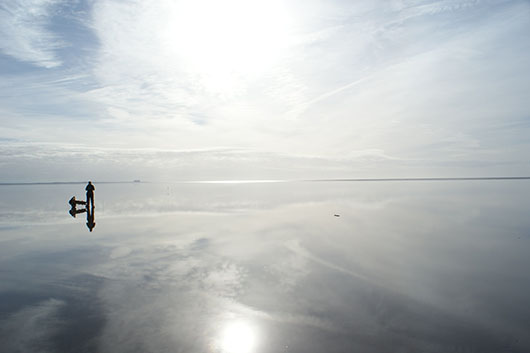Scientists return to Morecambe Bay

A team of scientists, led by the University of St Andrews, are returning to Morecambe Bay this week to look at how the plants and animals living in salt marshes and mudflats contribute to our natural environment, economy and society.
The 30 strong team of scientists first visited the Bay in February and will continue to study the role natural systems, such as salt marshes, play in the purification of water, the production of food and the protection of coastlines, as well as the provision of habitat for wildlife and recreational space for people.
The research team will study sites at West Plain, Cartmel Sands and Warton Sands until Sunday 11 August.
The initiative is part of a six year programme funded by the National Environment Research Council called CBESS (Coastal Biodiversity & Ecosystem Service Sustainability), a consortium made up of 14 research institutions concerned with the welfare and management of coastal systems, led by the University of St Andrews.
Meriem Kayoueche-Reeve, the CBESS Project Officer said: “The salt marshes and mudflats of Morecambe Bay offer an ideal location for the CBESS team to investigate and better understand the roles that microbes, plants and animals play in providing natures benefits.”

Dr Angus Garbutt, the CBESS Site Champion for Morecambe Bay said:
“Morecambe Bay is the largest continuous area of intertidal mud and sand flat in Britain covering 310km2. Because of its size and location the Bay offers many benefits to the 200,000 people who live and work around its shores and to the wider public; fisheries, heritage and landscape, recreation and tourism, and wildlife to name a few.”
“Although some of the benefits that intertidal areas provide are easy to see and value, others are more difficult measure and need scientific investigation in order fully explain their worth. Morecambe Bay is a great place to investigate these benefits because of its size, complexity and setting in one of the most beautiful and popular landscapes in Britain.”
The research that CBESS is undertaking has many real world applications. With combating the sources of climate change high on the political agenda salt marshes and mudflats also perform another important function by locking up carbon in muddy sediments. The project team is investigating the role that plants and animals living on the salt marshes and mudflats play and have deployed high tech scientific equipment to measure greenhouse gas emissions such as methane and carbon dioxide.
By the end of the project, the team will be able to provide a comprehensive review of the functions and benefits that the salt marshes and mudflats of Morecambe Bay provide to local people.
ENDS
Notes to Editors
Issued by the University of St Andrews Press Office. Contact Victoria Herd on 01334 462530/07850 900 351 or email [email protected].
Dr Angus Garbutt is available on +44 (0)1248 374500
Or contact Meriem Kayoueche-Reeve (CBESS Project Officer) on +44 (0)1334 463613
The study is part of a six year programme funded by NERC (National Environment Research Council) in 2011 called BESS (Biodiversity & Ecosystem Service Sustainability). BESS is made up of four research consortia which aim to understand these links in urban, coastal, lowland agricultural and upland river environments.
CBESS (Coastal Biodiversity & Ecosystem Service Sustainability) is a consortium made up of 14 research institutions, universities and organisations that is concerned with the welfare and management of coastal systems.
Category Research